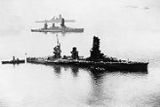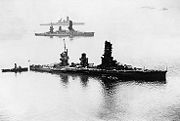
Pagoda Mast
Encyclopedia

Capital ship
The capital ships of a navy are its most important warships; they generally possess the heaviest firepower and armor and are traditionally much larger than other naval vessels...
s that were reconstructed during the 1930s in a bid to improve their fighting performance. These modifications were deemed to be necessary by the Imperial Japanese Navy
Imperial Japanese Navy
The Imperial Japanese Navy was the navy of the Empire of Japan from 1869 until 1947, when it was dissolved following Japan's constitutional renunciation of the use of force as a means of settling international disputes...
as a result of the "Battleships Holiday" that was imposed by the Washington Naval Treaty
Washington Naval Treaty
The Washington Naval Treaty, also known as the Five-Power Treaty, was an attempt to cap and limit, and "prevent 'further' costly escalation" of the naval arms race that had begun after World War I between various International powers, each of which had significant naval fleets. The treaty was...
, which strictly limited the construction of new battleships.
Pagoda masts featured a mass of platforms that included watch points, searchlights, and spotting points. The superstructures were constructed on the majority of the ships that were rebuilt by the Japanese, including the Kongō class battlecruisers
Kongo class battlecruiser
The were a class of ships of the Imperial Japanese Navy constructed immediately before World War I. Designed by British naval architect George Thurston, the lead ship of the class was the last Japanese capital ship constructed outside of Japan. Displacing upon completion, the vessels of this...
and the Fusō
Fuso class battleship
The Fusō-class battleships were two battleships of the Imperial Japanese Navy constructed during World War I. Displacing upon completion, and , the vessels of this class, were the first super-dreadnoughts of the IJN. They were completed from 1915 to 1917, both in Japanese shipyards...
, Ise
Ise class battleship
Originally intended as sister ships of the preceding Fusō class, the of the Imperial Japanese Navy were considered sufficiently different to warrant separate classification....
, and Nagato
Nagato class battleship
The were two battleships of the Imperial Japanese Navy. The name Nagato comes from the Nagato province. They were the first battleships to be built entirely in Japan...
class battleship
Battleship
A battleship is a large armored warship with a main battery consisting of heavy caliber guns. Battleships were larger, better armed and armored than cruisers and destroyers. As the largest armed ships in a fleet, battleships were used to attain command of the sea and represented the apex of a...
s. The additional platforms were supported on the ships' original tripod foremasts (a design also extensively used by the Royal Navy
Royal Navy
The Royal Navy is the naval warfare service branch of the British Armed Forces. Founded in the 16th century, it is the oldest service branch and is known as the Senior Service...
) and these were suitably strengthened to bear the extra weight they had to carry.
Like the British
United Kingdom
The United Kingdom of Great Britain and Northern IrelandIn the United Kingdom and Dependencies, other languages have been officially recognised as legitimate autochthonous languages under the European Charter for Regional or Minority Languages...
Royal Navy
Royal Navy
The Royal Navy is the naval warfare service branch of the British Armed Forces. Founded in the 16th century, it is the oldest service branch and is known as the Senior Service...
, which was considered to be the likely enemy of Japan in the event of an armed conflict, the Imperial Japanese Navy wanted to prepare their warships for engaging in combat during the night. Prior to the outbreak of World War II
World War II
World War II, or the Second World War , was a global conflict lasting from 1939 to 1945, involving most of the world's nations—including all of the great powers—eventually forming two opposing military alliances: the Allies and the Axis...
, powerful searchlight
Searchlight
A searchlight is an apparatus that combines a bright light source with some form of curved reflector or other optics to project a powerful beam of light of approximately parallel rays in a particular direction, usually constructed so that it can be swiveled about.-Military use:The Royal Navy used...
s were strategically placed on the pagoda masts for the purpose of locating the position of enemy ships in nighttime conditions. However, during the early 1940s, the searchlights mounted on the pagoda became less important as new radar
Radar
Radar is an object-detection system which uses radio waves to determine the range, altitude, direction, or speed of objects. It can be used to detect aircraft, ships, spacecraft, guided missiles, motor vehicles, weather formations, and terrain. The radar dish or antenna transmits pulses of radio...
technology was developed that allowed a ship to aim and shoot at targets located "over the horizon".
In the navies of Europe
Europe
Europe is, by convention, one of the world's seven continents. Comprising the westernmost peninsula of Eurasia, Europe is generally 'divided' from Asia to its east by the watershed divides of the Ural and Caucasus Mountains, the Ural River, the Caspian and Black Seas, and the waterways connecting...
and the Americas
Americas
The Americas, or America , are lands in the Western hemisphere, also known as the New World. In English, the plural form the Americas is often used to refer to the landmasses of North America and South America with their associated islands and regions, while the singular form America is primarily...
, tall pagoda-style masts were generally frowned upon. Naval architects
Naval architecture
Naval architecture is an engineering discipline dealing with the design, construction, maintenance and operation of marine vessels and structures. Naval architecture involves basic and applied research, design, development, design evaluation and calculations during all stages of the life of a...
and sailors from the Western hemisphere claimed that the Japanese battleships were too "top-heavy" and critics often mocked these vessels by nicknaming them "Christmas Trees". Regardless of how valid these criticisms actually were, some of the pagoda masts that were built on Japanese warships during the 1930s were indeed very large. For instance, the top of the pagoda mast of the Imperial Japanese battleship Fuso was 40 metres (131.2 ft) above the waterline.

